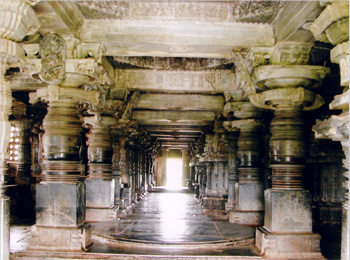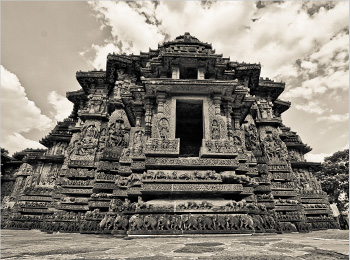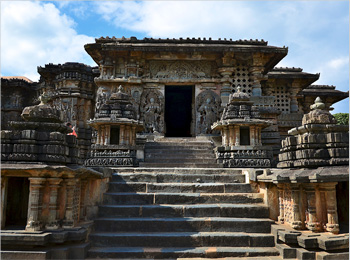- Shiva
Hoysaleswara temple
- Halebeedu,Karnataka
- View on map
- Tell us about this temple
Overview
The Hoysaleswara Temple is deciated to Lord Shiva and is located in Karnataka, India. Hoysaleswara temple is a temple dedicated to the Hindu God Shiva.
About the temple

It was built in Halebidu (in modern Karnataka state) during the Hoysala Empire's rule in the 12th century by King Vishnuvardhana. The construction was completed in 1121 CE. During the early 14th century, Halebidu was sacked and looted by Muslim invaders from northern India and the temple fell into a state of ruin and neglect. From historical records it is known that the temple derives its name from the Hoysala ruler at that time, King Vishnuvardhana Hoysaleswara, though interestingly, the construction of the temple was initiated and financed by wealthy Shaiva citizens of the city, prominent among who were Ketamalla and Kesarasetti. The temple building activity was taken up in competition to the construction of the Chennakesava temple at Belur, a Vaishnava temple. The temple faces a large tank which was built in the middle of the 11th century and received water through channels from an ancient dam built over the Yagachi River. The tank preceded the temple by nearly seventy five years. It is one of the largest temples dedicated to God Shiva in South India.
The temple is a simple dvikuta vimana (two shrined), one for ""Hoysaleswara"" and the other for ""Shantaleswara"" (after Shantala Devi, queen of king Vishnuvardhana) and is built with chloritic schist (soapstone, also known as potstone). The temple complex as a whole is elevated on a jagati (platform), a feature that became popular in contemporary Hoysala designs. The two shrines which are adjoining, face east and each have a mantapa (or hall) in front. The two mantapas are connected giving a large and imposing view of the hall. Individually, each shrine is smaller than the one at the Chennakesava temple at Belur and contains a simple Linga, the universal symbol of Shiva. The plan of the inside of the temple is simple but the exterior looks different because of the introduction of many projections and recesses in the walls. The towers of the shrines that are missing must have followed the star shape of the shrine, just as in many existing well preserved towers in other Hoysala temples. The superstructure of the vestibule (which connects the shrine to the mantapa), called Sukanasi, and the row of decorated miniature roofs above the eaves of the hall are all missing. The temple was built at a height that provided the architects sufficient horizontal and vertical space to depict large and small sculptures. The overall effect of the vertical and horizontal lines, the play of the outline, the effect of light and shade and the plan of the projections and recesses all amounts to a "marvellous exhibition of human labor to be found even in the patient east and surpasses anything in Gothic art". The outer walls of these temples contain an intricate array of stone sculptures. The temple of Halebidu, has been described as an ""outstanding example of Hindu architecture"" and as the ""supreme climax of Indian architecture". The temple has four porches for entry and the one normally used by visitors as main entry today is actually a lateral entrance (north). There is one entry on the south side and two on the east side, facing two large detached open pavilions whose ceiling is supported by lathe turned pillars. All entry porches have miniature shrines as flanking. In addition there is a sanctuary for the Sun God Surya, whose image stands 7 feet (2.1 m) tall. The pavilions enshrine large images of Nandi, the bull, an attendant of Shiva. The pavilions share the same jagati as the main temple. As in the Chennakesava temple, this temple originally had an open mantapa to which, outer walls with pierced window screens made with the same material were erected, making the mantapa a closed one. The window screens are devoid of any art work. The interior of the temple is quite plain except for the lathe turned pillars that run in rows between the north and south entrances. The four pillars in front of each shrine are the most ornate and the only ones that have madanika sculptures in their pillar brackets. There are no other madanikas in the temple.The temple derives its name from the Hoysala ruler at that time, King Vishnuvardhana Hoysaleswara, though interestingly, the construction of the temple was initiated and financed by wealthy Shaiva (a Hindu sect) citizens of the city, prominent among who were Ketamalla and Kesarasetti. It faces a large tank which was built in the middle of the 11th century and received water through channels from an ancient anecut (dam) built over the Yagachi River.The tank preceded the temple by nearly 75 years. It is one of the largest temples dedicated to the god Shiva in South India.
The Hoysaleswara temple is most well known for its sculptures that run all along the outer wall, starting with an dancing image of the god Ganesha on the left side of the south entrance and ending with another image of Ganesha on the right hand side of the north entrance. In all there are two hundred and forty such images. The temple is a simple dvikuta vimana (plan with two shrines and two superstructures), one for ''Hoysaleswara'' (the king) and the other for ''Shantaleswara'' (named after Shantala Devi, queen of King Vishnuvardhana) and is built with chloritic chist (more commonly known as Soapstone or potstone).The temple complex as a whole is elevated on a jagati (platform), which according to historian Kamath, is a feature that became popular in contemporary Hoysala constructions. According to art critic Foekema, the two shrines which are adjoining, face east and each have a mantapa (hall) in front. The two mantapas are connected giving a large and imposing view of the hall. Individually, each shrine is smaller than the one at the Chennakesava Temple at Belur and contains a simple linga, the universal symbol of the god Shiva. The plan of the inside of the temple is simple but the exterior looks different because of the introduction of many projections and recesses in the walls. The towers of the shrines that are missing must have followed the star shape of the shrine, just as in many existing well preserved towers in other Hoysala temples.The temple has four porches for entry and the one normally used by visitors as main entry is actually a lateral entrance (north). There is one entry on the south side and two on the east side, facing two large detached open pavilions whose ceiling is supported by lathe turned pillars. All entry porches have miniature shrines as flanking.The pavilions enshrine large images of Nandi, the bull, an attendant of Shiva. The pavilions share the same jagati as the main temple. As in the Chennakesava temple, this temple originally had an open mantapa to which outer walls with pierced window screens made with the same material were erected, making the mantapa a closed one. The window screens are devoid of any art work.The interior of the temple is quite plain except for the lathe turned pillars that run in rows between the north and south entrances. According to Settar, the four pillars in front of each shrine are the most ornate and the only ones that have the madanika (chaste maidens) sculptures in their pillar brackets. There are no other madanikas in the temple. The Hoysaleswara temple is most well known for its sculptures that run all along the outer wall, starting with a dancing image of the god Ganesha on the left side of the south entrance and ending with another image of Ganesha on the right hand side of the north entrance. In all there are two hundred and forty such images.
About the Deity
The Hoysaleswara temple, dedicated to Lord Shiva, is built on a star shaped platform. This temple hallows Hoyasaleswara and Santaleswara.
Best time to visit
November to March
Significance
One of the largest temples dedicated to Lord Shiva in South India
Accessibility

One can easily reach Hoysaleswara Temple by taking regular Buses or by hiring taxis from anywhere in Karnataka. Halebeedu is 30Kms from the district head quarters, Hassan in North direction. The temple is about half a kilometre from the bus station of Halebid. You can even come to Hassan and then come to Hoysaleswara temple. There are State Road Transport Corporation buses that ply between Hassan and Halebid. There is no airport at Hassan but there are many trains that ply between Mysore, Bangalore and Hassan.One can make flight bookings up to Bangalore or Mysore and then take a bus or a train to Halebid or Hassan. Shivratri is an ideal time to visit this temple.
Address
Hoysaleswara Temple,
Halebeedu, Belur,
Hassan,
Karnataka
Significance
Devotees visit this temple to seek fulfillment of the following:-
- Salvation
- Wealth
- Relief from diseases
- Purchase of vehicles
- Gain Knowledge
Shlokas
Kailaasarana Shiva Chandramouli Phaneendra Maathaa Mukutee Zalaalee Kaarunya Sindhu Bhava Dukha Haaree Thujaveena Shambho Maja Kona Taaree
Meaning -Oh Lord Shiva who is seated on Mount Kailash, where the moon decorates his forehead and the king of serpents crown his head, who is merciful and removes delusion, You alone can protect me. I surrender to thee.
Aum Trayambakam Yajaamahey Sugandhim Pusti Vardhanam Urvaarukamiva Bandhanaath Mrutyor Muksheeya Maamritaat
Meaning -We worship the fragrant Lord Shiva, who has 3 eyes and who cultivates all beings. May He free me from death, for immortality, as even a cucumber is separated from its bond with the vine.
